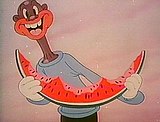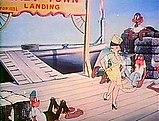
Walter Lantz Productions was an American animation studio. It was in operation from 1928 to 1972 and was the principal supplier of animation for Universal Pictures.
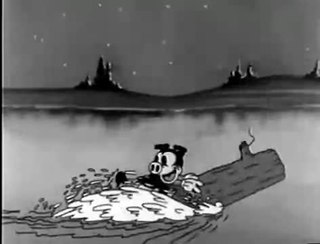
The Censored Eleven is a group of Looney Tunes and Merrie Melodies cartoons originally produced and released by Warner Bros. that have been withheld from syndication in the United States by United Artists (UA) since 1968. UA owned the distribution rights to the Associated Artists Productions library at that time, and decided to pull these 11 cartoons from broadcast because the use of ethnic stereotypes in the cartoons, specifically African and African-American stereotypes, was deemed too offensive for contemporary audiences.
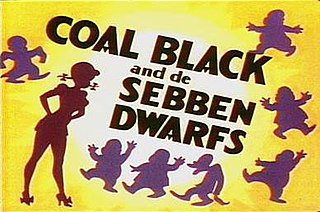
Coal Black and de Sebben Dwarfs is a 1943 Merrie Melodies animated cartoon directed by Bob Clampett. The short was released on January 16, 1943.

A mammy is a U.S. historical stereotype depicting black women, usually enslaved, who did domestic work, including nursing children. The fictionalized mammy character is often visualized as a dark-skinned woman with a motherly personality. The origin of the mammy figure stereotype is rooted in the history of slavery in the United States, as slave women were often tasked with domestic and childcare work in American slave-holding households. The mammy caricature was used to create a narrative of black women being happy within slavery or within a role of servitude. The mammy stereotype associates black women with domestic roles and it has been argued that it, combined with segregation and discrimination, limited job opportunities for black women during the Jim Crow era, approximately 1877 to 1966.

The Woody Woodpecker Show is an American television series mainly composed of the animated cartoon shorts of Woody Woodpecker and other Walter Lantz characters including Andy Panda, Chilly Willy, The Beary Family and Inspector Willoughby all released by Walter Lantz Productions. The series was revived and reformatted several times, but remained popular for nearly four decades and allowed the studio to continue making theatrical cartoons until 1972 when it shut down. It also kept the Walter Lantz/Universal "cartunes" made during the Golden Age of American animation a part of the American consciousness. The Woody Woodpecker Show was named the 88th best animated series by IGN.

Sunday Go to Meetin' Time is a 1936 Warner Bros. Merrie Melodies cartoon directed by Friz Freleng. The short was released on August 8, 1936. The name of the short comes from the colloquial adjective "sunday-go-to-meeting", describing something appropriate for church or otherwise presentable.
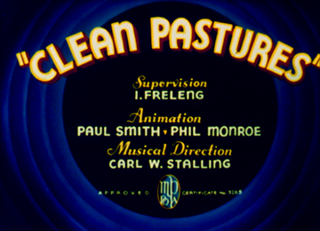
Clean Pastures is a 1937 Warner Bros. Merrie Melodies cartoon directed by Friz Freleng. The short was released on May 22, 1937.

Angel Puss is a 1944 Warner Bros. Looney Tunes cartoon directed by Chuck Jones. The short was released on June 3, 1944.
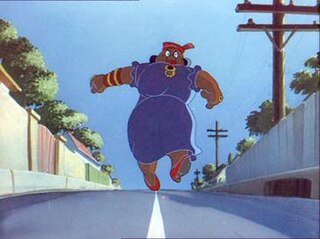
Mammy Two Shoes is a fictional character in MGM's Tom and Jerry cartoons. She is a middle-aged African American woman who is the housemaid in the house which Tom and Jerry reside. But the fact that she has her own bedroom in the short Sleepy-Time Tom (1951) raises the possibility of her being the owner of the house, as no other human is present in the house in shorts she appears. She would scold and discipline Tom whenever she believed he was misbehaving; Jerry would sometimes be the cause of Tom's getting in trouble.
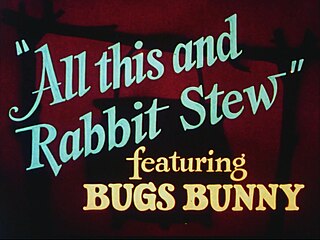
All This and Rabbit Stew is a 1941 Merrie Melodies cartoon directed by Tex Avery. The cartoon was released on September 13, 1941, and features Bugs Bunny.
Joseph Benson Hardaway was an American storyboard artist, animator, voice actor, gagman, writer and director for several American animation studios during The Golden Age of Hollywood animation. He was sometimes credited as J. B. Hardaway, Ben Hardaway, B. Hardaway and Bugs Hardaway. He fought in World War I in the 129th Field Artillery Regiment, Battery D.

"Boogie Woogie Bugle Boy" is a World War II jump blues song written by Don Raye and Hughie Prince which was introduced by The Andrews Sisters in the Abbott and Costello comedy film, Buck Privates (1941). The Andrews Sisters' Decca recording reached number six on the U.S. pop singles chart in the spring of 1941 when the film was in release. The song is ranked No. 6 on Songs of the Century. Bette Midler's 1972 recording of the song also reached the top ten on the U.S. Billboard Hot 100.
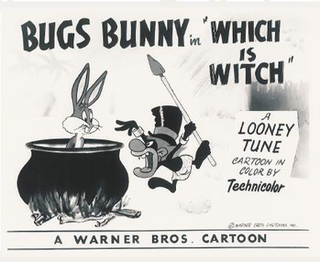
Which Is Witch is a Looney Tunes cartoon released by Warner Bros. in 1949, directed by Friz Freleng and written by Tedd Pierce. The cartoon was released on December 3, 1949, and features Bugs Bunny.

Hittin' the Trail for Hallelujah Land is a 1931 Warner Bros. Merrie Melodies animated cartoon directed by Rudolf Ising. The short was released on November 28, 1931, and stars Piggy.

Little Black Sambo is a 1935 Cinecolor animated film with sound. Released on February 6, 1935, the short is based on the controversial 1899 children's book The Story of Little Black Sambo by Helen Bannerman. This film was created at the Ub Iwerks Studio and released by Celebrity Productions. The film marked the first appearance of an unnamed dog who appeared in three of Iwerks' films.
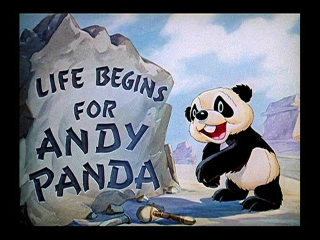
Life Begins for Andy Panda is a 1939 American short subject cartoon created by Walter Lantz, as the first Andy Panda film.

The watermelon stereotype is an anti-Black racist trope originating in the Southern United States. It first arose as a backlash against African American emancipation and economic self-sufficiency in the late 1860s.

Swing Symphony is an American animated musical short film series produced by Walter Lantz Productions from 1941 to 1945. The shorts were a more contemporary pastiche on Walt Disney's Silly Symphonies, and often featured top boogie-woogie musicians of the era. While the first cartoon include the characters Woody Woodpecker and Andy Panda, it mainly features a variety of different characters created exclusively for the series, with Oswald the Lucky Rabbit making an appearance in one cartoon.

September in the Rain is a 1937 Warner Bros. Merrie Melodies cartoon directed by Friz Freleng. The short was released on December 18, 1937.
Events in 1941 in animation.

